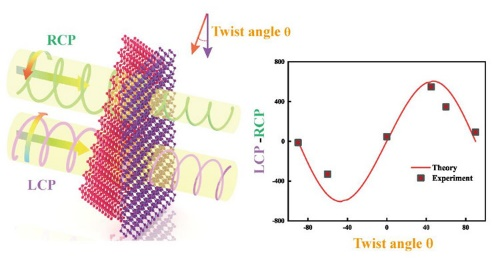NKU Team Realizes Highly Tunable Large Optical Chiral Response in Twisted 2D Materials

Figure 1 (Left) Schematic diagram of chiral properties of twisted anisotropic two-dimensional materials; (Right) Theoretical and experimental results of optical activity with different twist angles.
Recently, the latest research findings of twisted two-dimensional materials by the research team led by Professor Liu Zhibo and Tian Jianguo of the School of Physics of Nankai University and the TEDA Institute of Applied Physics were published in ACS Nano, a well-known international academic journal in the field of materials. They employed the newly developed transfer technology to prepare high-quality, high-precision twisted anisotropic 2D material structures (twisted black phosphorus, twisted rhenium disulfide, etc.), realizing highly tunable large optical chiral response. This response covers a broad spectral range from visible to infrared light.
The research team has been devoted to the preparation of twisted two-dimensional materials and the research on optoelectronic properties for many years, and has realized the preparation of double-twisted controllable trilayer graphene for the first time in the world (Advanced Materials, 2016, 28, 2563), and obtained a new diode with twisted black phosphorus (Advanced Materials, 2018, 30, 1704653).
This research reports a miniaturized chiral device based on twisted anisotropic 2D materials that can accurately encode chiral properties through symmetry, energy band, and anisotropic engineering. The research team developed a new dry transfer method to prepare a variety of twisted 2D material structures, and built a high-precision and micro-test platform of circular dichroism for measuring the optical chiral response of materials. It was discovered that the material system forms large optical chiral properties due to the symmetry breaking caused by the twist and chirality is highly tunable in a wide spectral range. The largest optical chiral response in the 2D material chirality system was obtained. Finally, the spinning encryption and decryption transmission of photoelectric information were realized using the twisted anisotropic 2D material structure. The research findings show that twisted anisotropic 2D materials have great potential in the integration application of nanophotonic devices.
Link to the paper:
https://pubs.acs.org/doi/10.1021/acsnano.3c06031
(Edited and translated by Nankai News Team.)









